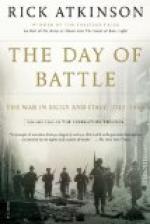Haynau who was sent to replace Nugent, was already known at Brescia, where he had been appointed military governor after the resumption of Austrian authority in 1848. In order to punish the ’persistent opposition manifested to the legitimate Imperial and Royal Government,’ and as an example to the other towns, he had imposed on the Brescian householders and the landed proprietors of the province a fine of half a million francs.
He now returned, and what he did may be best read in his own report on the operations. ‘It was then,’ he wrote, ’that began the most murderous fight; a fight prolonged by the insurgents from barricade to barricade, from house to house, with extraordinary obstinacy. I should never have believed that so bad a cause could have been sustained with such perseverance. In spite of this desperate defence, and although the assault could only be effected in part, and with the help of cannons of heavy calibre, our brave troops with heroic courage, but at the cost of great losses, occupied a first line of houses; but as all my columns could not penetrate into the town at the same time, I ordered the suspension of the attack at nightfall, limiting myself to holding the ground conquered. In spite of that, the combat continued late into the night. On the 1st of April, in the earliest morning light, the tocsin was heard ringing with more fury than ever, and the insurgents reopened fire with an entirely new desperation. Considering the gravity of our losses, as well as the obstinacy and fury of the enemy, it was necessary to adopt a most rigorous measure. I ordered that no prisoners should be taken, but that every person seized with arms in his hand should be immediately put to death, and that the houses from which shots came should be burnt. It is thus that conflagrations, partly caused by the troops, partly by the bombardment, broke out in various parts of the town.’
During the ten days’ struggle, the citizens did not flinch for a moment. Count Martinengo was the guiding spirit of the defence, and scarcely left the most exposed of the barricades night or day. From the nobles to the poorest of the people, all did their duty. A youth named Tito Speri led and animated the populace. The horrors of the repression make one think of the fall of Khartoum. Not even in Hungary, where he went from Brescia to continue his ‘system,’ did Haynau so blacken his own and his country’s name as here. In a boys’ school kept by a certain Guidi, the master’s wife, his mother and ten of his pupils were slaughtered. A little hunchback tailor was carried to the barracks to be slowly burnt alive. But stray details do not give the faintest idea of the whole. And for all this, Haynau was in a far higher degree responsible than the actual executants of the vengeance to which he hounded on his ignorant soldiers, maddened with the lust of blood.




